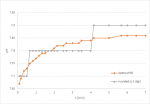Just chiming in to say I recently picked up an Apera PH60, and it's great! Being colorblind, it's frustrating to have to chase someone down in the house to compare the colors. And then depending on who I find, they interpret the colors differently; so I've been concerned with consistency.
When I ordered my TF-100, I also ordered a pH meter from tftestkits.net. When it arrived, the LCD screen was cracked, so they sent me a replacement. They said to just throw the 1st one away.
So I actually tried both of the pH pens from tftestkits.net, and neither read accurately. I even bought calibration and storage solutions from AtlasScientific, instead of relying on the powder that came with the meters; but neither would read accurately on the pool water, nor our fishtank water, nor our tap water. If I calibrated it for the 4.00 pH solution, it would be off for the 7 and 10 solutions, and visa-versa ...
So I finally broke down and bought the
Apera PH60 for $80, and used the calibration solutions which came with it to calibrate it. It's dead on for all 3 calibration solutions, and seems to be accurate for the pool, fish tank, and our tap water

I notice when 1st turning it on, and placing it into the water ... it does jump around a lot for a few mins. Like +10 to -2 jumpy readings. Once it's been on for a few minutes, it stabilized and then reads very quickly, even when moving it between samples (ie: pool water, to fishtak water, to tap water) it only takes 3-4 seconds for the smiley face to appear and the reading to stop moving around.
I wonder if the probe needs a bit of time to warm up maybe? I think I read that somewhere else, that you should turn on a pH probe a few minutes before using it to take a measurement. Something about the electrical current passing through the tip causing a temp rise (or resistance change maybe) for the 1st few minutes?
Either way, I'm so glad I got it; It definitely makes life a lot easier for me!


